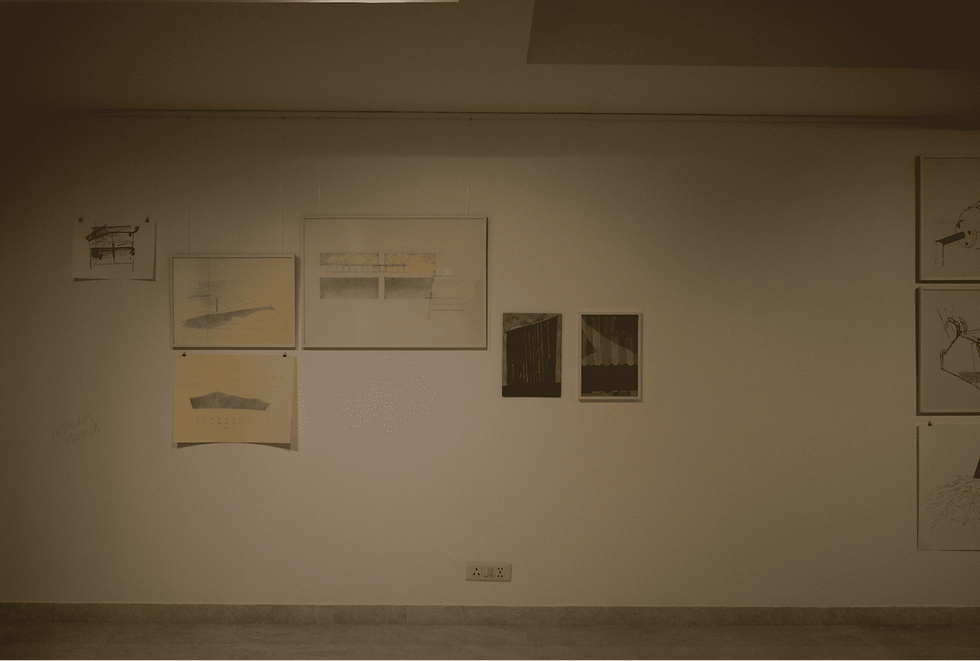অনুরণন:ঘিটোর্নীর নিঃশব্দ সংলাপ, 2024-2025
(Resonance: Ghitorni's Silent Dialogues)
This project was undertaken during "Art For Art Residency and mentorship program",Mentored by Artist Vasudha Thozhur.

Ghitorni, a village in the southwestern part of Delhi, near the Gurgaon border and Vasant Kunj, has a rich history that spans over a thousand years, shaped by migrations, conflicts and cultural integration. It has been said that approximately 1300 years ago, a group of Gujjars started from Ujjain in Madhya Pradesh, made their way through Rajasthan and settled near Gudi, a small village in Delhi.
This small village was populated by Brahmins and Pandits. In a battle with the original inhabitants, the Gujjars took over the village and renamed it Ghitorni.
This historical and cultural context of Ghitorni provides a backdrop for understanding the complexities of urban life in contemporary Delhi. The village is not only a geographic location but a dynamic space continuously shaped by human interaction, cultural practices and social structures. A detailed exploration of Ghitorni’s urban fabric reveals how individual spaces within the village contribute to a larger, interconnected identity.
The study employed a phenomenological methodology, transcending traditional urban recording by focusing on subjective/lived experiences while maintaining analytical rigour. It examined three key locales in Ghitorni—Sabzi Mandi Gali, 100 Ft Road and Forest Lane—each representing different aspects of the urban experience. The research methodology incorporated temporal observations conducted across different times of the day, utilising various sensory recording techniques, such as sketches, photographs, video recordings and sound recordings. This allowed the study to capture the sensory, emotional and temporal shifts that occur in the village.
The thematic exploration of Ghitorni in the research focused on three critical dimensions: identity, temporal dynamics and interconnectedness/time. Ghitorni represents a complex urban ecosystem where spatial identity emerges through continuous ecological and cultural negotiations. Forest Lane exemplifies this dynamic, functioning as a critical boundary between urban expansion and environmental preservation. The research reveals urban spaces as fluid constructs, transformed by daily rhythms, human activities, and sensory interactions. By employing multi-sensory methodologies, the study captures Ghitorni's intricate landscape of spatial transitions, demonstrating how individual spaces contribute to a collective urban narrative of perpetual metamorphosis.

Sabzi Mandi Gali
100 ft Road
Forest Lane

Excerpts from Diary

Excerpts from Diary

Excerpts from Diary

Excerpts from Diary

Graphite pencil,colour pencil on paper 3 ft X 2 ft

Graphite pencil ,Colour Pencil on Paper 1.4 ft x 1 ft

Gouache on paper 16.5 Inches X 11.5 Inches

Graphite pencil,colour pencil on paper 3 ft X 2 ft

Pen on paper 3 ft X 2 ft

Pen on paper 3 ft X 2 ft

Pen on Paper 17 Inches X 12 Inches

Pen on paper 3 ft X 2 ft

Pen on paper 3 ft X 2 ft

Pen on Paper 2.5 ft X 1.9 ft

Graphite pencil on paper 1.4 ft X 1 ft

Pen on paper 3 ft X 2 ft

Gouache on paper 8.3 inches X 5.8 inches

Gouache on paper 8.3 inches X 5.8 inches

Gouache on paper 16.5 Inches X 11.7 Inches

Gouache on paper 8.3 inches X 5.8 inches

pen on paper 3 ft X 2 ft

Graphite Pencil on Paper 17 Inches X 12 Inches

Archival Print on Paper

pen on paper 3 ft X 2 ft


Installion View of the Project (Champatree Art Gallery,New Delhi)

Installion View of the Project (Champatree Art Gallery,New Delhi)
